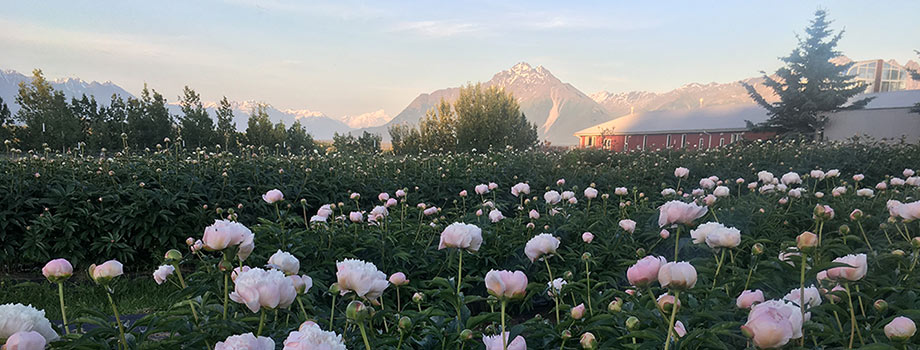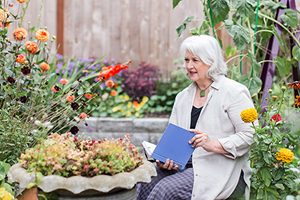- 3 Easy, Reliable, Productive Cut Flowers: Sunflowers, Zinnias & Rudbeckia
- 5 Factors That Determine Vase Life of Cut Flowers
- 2019 American Flowers Week: Combining the Art of Floral Design & Couture
- Celebrate the 7th American Flowers Week | Johnny's 2021 Botanical Couture
- Celebrating the 8th American Flowers Week | Johnny's 2022 Botanical Couture
- Collective Selling Models for Flower Farmers: Flower Hubs That Work
- 5 Cool Flowers to Plant Now | Lisa Mason Ziegler's Secrets for Growing Hardy, Cool-Season Annuals
- Cut-Flower Harvesting & Post-Harvest Care | Best Practices from Pros in the Slow Flower Community
- Cut-Flower Kit | Guide for Market Growers (PDF)
- Easy Cut-Flower Garden Map | For Growers New to Flowers (PDF)
- Easy Cut-Flower Garden Planner | For Growers New to Flowers (PDF)
- From Color to Climate: 5 Floricultural Trends Subtle & Seismic
- Flower Culture by Crop | Comparison Chart | Days to Germination, Weeks to Transplant, Days to Harvest (PDF)
- Flower Farmers' Favorite Fillers & Foliage | Recommendations from 3 Farmer-Florists
- Getting Started in Cut-Flowers | Top 15 Cuts
- Heat & Drought: How Flower Farmers Are Adapting to Changing & Challenging Climatic Conditions
- Introduction to Overwintering Flowers | Guide to Overwintering Flowers
- An Introduction to Producer Marketing Cooperatives | M Lund & Associates
- How Day Length Affects Cut-Flower Production
- Flower Power for Roadside Markets
- Growing Flowers in Hoophouses & High Tunnels: Cool-Weather & Hot-Weather Options
- Tips for Starting a U-Pick Flower Operation
- Year-Round Flower Production Strategy
- Overwinter Flower Trials | Multiyear Results for 30+ Crops | Johnny's Selected Seeds | XLSX
- Seeding Date Calculator | Johnny's Recommended Flowers for Overwintering | XLSX
- Pricing & Profitability for Flower-Farmers | Pointers from a Diversity of Pros
- Just Add Flowers | An Introduction to Companion Planting for Vegetable & Herb Gardeners
- Sustainable Farming Methods | A Survey of Flower Farmers' Best Practices
- Slow Flowers Palette & Petal Crushes | Evolving Colors & Shape-Shifts in Floral Industry Trends
- Johnny's & Slow Flowers | Johnny's Selected Seeds
- Slow Flowers | Celebrating Fifth-Season Regional Design Elements
- Slow Flowers Floral Forecast | A Summary of Industry Insights & Trends
- Slow Flowers | Building a Better Market Bouquet | Tips & Techniques for Flower Farmers
- Slow Flowers | Tips for Staging On-Farm Floral Workshops | Johnny's Selected Seeds
- Wedding Wisdom 101 | 10 Beginner Tips for Entering the Wedding Floral Landscape
- Succession-Planting Flowers | Scheduling & Planning, Sowing Frequency, Recordkeeping & Recommendations
- Succession-Planting Interval Chart for Flowers
- Sustainable Floral Design | Techniques & Mechanics for Foam-Free Floristry | Tobey Nelson & Debra Prinzing
- Video: Mason Jar Bouquet Tutorial
- Video: How to Build a Bouquet
- Video: Tobey Nelson | Sustainable Floral Design | Slow Flowers Summit
- Video: Economic Considerations in Overwintering Cut Flowers | Johnny's Selected Seeds
- Top 10 Cut-Flower Varieties for Direct Seeding
- Video: Floating Row Cover | Baby "Cool Flower" Protection from Whipping Winter Winds
- Video: The Procona System for All-in-one Flower Harvest, Transport & Display
- Johnny's Overwinter Flowers Tunnel: Trellising, Supports, Ground Cover & Spacing
- Video: Irrigation Considerations for the Overwinter Flowers Tunnel | Johnny's Selected Seeds
- Video: Johnny's Overwinter Flowers Trial Recap
- Video: Producer Cooperatives for Small-Scale Farmers | Johnny's Webinar Series
- Climate Adaptation for Vegetable & Flower Farmers | Johnny's Educational Webinar Resources
- Choosing Flower Crops to Overwinter | Guide to Overwintering Flowers
- Edible Flowers List: Top 20 Favorites from the Slow Flowers Community
- Bloom to Boom: Flower Farm Profitability
- Choosing Tulip Varieties for Forcing | Guide to Forcing Flower Bulbs
- Forcing Tulip Bulbs | Guide to Forcing Flower Bulbs
- Snapdragon Groups Explained
- Flowering in the South: Profiles of 5 flower farmers who cope with temperature, humidity, pest & weed pressure
- Video: Flower Growing in Southern States | Johnny's Webinar Series
- 10 Tips for Building a Profitable Cut-Flower Business
- Introduction to Forcing Flower Bulbs in Soil | Guide to Forcing Flower Bulbs
- Eat Your Flowers: Serve Up That Wow Factor With Edible Flowers
- Flower Growing in Southern States | Johnny's Educational Webinar Series
- Chrysal Clear Universal Flower Conditioner | SDS
- Chrysal Classic Professional 2 Transport & Display (Holding) Solution | SDS
- Chrysal Professional 2 Transport & Display T-Bag | SDS
- Chrysal Clear Bulb Flower Conditioner | SDS
- Webinar Slide Deck | New-for-2023 Flowers & Floral Supplies | PDF
- Chrysal CVBN Flower Conditioner | SDS
- Chrysal Clear Bulb T-Bag | Cut-Flower Conditioner | SDS
- Chrysal Professional 1 Hydration Solution | SDS
- Chrysal Professional 3 Vase Solution Powder | SDS
- Webinar Slide Deck | Flower Growing in Southern States | PDF
- When to Start Seeds for Overwintered Flowers | Guide to Overwintering Flowers
3 business models for disrupting the conventional wholesale marketplace:
• Legal Cooperative • Multi-Owner LLC • For-Profit Wholesale Business
Flower Hubs That Work
Martha Lojewski, owner of Mt. McKinley Peonies in Willow, Alaska, describes the classic dilemma for most farmers:
“ You want to farm, but you cannot farm and sell and go to market and do all the marketing well. ”
That common pain point feels more acute for growers in the highly diversified world of specialty cut flowers and even for an Alaska peony grower who has six or seven weeks to generate an entire year of income from one crop.
In 2015, after a couple years researching collective flower marketing options, Lojewski and a handful of other peony growers formed the Alaska Peony Cooperative, for which Lojewski now serves as executive director. "We knew it was the right business model because it encouraged everybody to work together rather than doing everything on their own," she says.
Four years earlier in 2011, a group of flower farmers in the Pacific Northwest formed the Seattle Wholesale Growers Market with a similar motivation, as explained by co-founder Diane Szukovathy: "We could not figure out any better way to do all the work of farming and the work of selling our flowers. Even with all the board meetings and all the other work, the gold of this co-op is that we own ourselves."
The regional flower cooperative just celebrated its ten-year birthday, a remarkable milestone that Szukovathy and her fellow member-owners achieved through sweat-equity, determination, and support from their floral design customers. Szukovathy owns Jello Mold Farm in Mt. Vernon, Washington, with her partner Dennis Westphall, and like Lojewski, she fields dozens of phone calls and emails each season from groups of flower farmers who want to create something similar in their regions.
Since the SWGMC is located in my backyard, and thanks to my relationships with so many of the Oregon and Washington flower growers who participate, I have enjoyed a front-row seat to a blossoming of the cooperative flower-selling model. I describe attending SWGMC's original planning meeting, which took place in June 2011, in The 50 Mile Bouquet, and that event was central to my formation of the Slow Flowers Movement.
What Are Your Options?
It's no wonder that over the past 10 years interest in collectives, cooperatives, and co-marketing models has been on the rise. This sharp increase runs in tandem with the general explosion of new flower farmers and increased demand among florists for local and seasonal product. But there is no one-size-fits-all template, which has been frustrating for some startup groups.
A closer look reveals many options and opportunities. This article reviews three popular options for creating a regional wholesale flower hub: Legal Cooperative; Multi-Owner LLC; and For-Profit Wholesale Business.
There are many variations on these three themes, but these three provide a good introduction to collective selling models for flower farmers. I spoke with several Slow Flowers members who have formed regional marketing hubs to learn about the basic tenets and appeal of each model.
1 • Wholesale Flower Cooperative
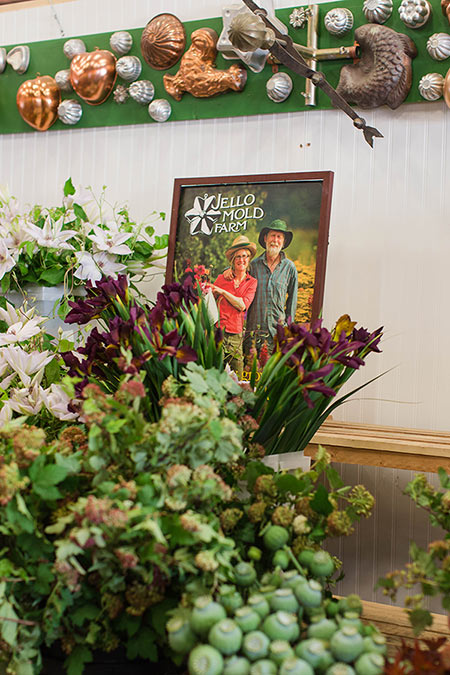
Photo: Missy Palacol Photography
Their vast geography led the founding farmers of Seattle Wholesale Growers Market (SWGMC) to choose the co-op model, Szukovathy says. "We saw the vacuum in Seattle, which is where we wanted to sell our flowers. Originally, the flower farms located in Skagit Valley, where our farm is based, thought we could all drive to a central parking lot, back up our trucks in a circle and publicize it. But several of the Oregon farmers who would have to drive six or seven hours, said, 'We've got to have cooler storage when we get to Seattle.' That caused us to find a lease on a building, which snowballed into a different scenario."
Like the little engine that could, the SWGMC has come into its own through sheer optimism and tenacity. "When I look back, there was no other way to do it," Szukovathy admits. "We were not capitalized enough for the leap we made to start and it was very stressful for the first five to seven years of scrapping and grinding. But we've made it work. We didn't do it the way they tell you you're supposed to do it in business school, that's for sure."
SWGMC now acts as a flower farming incubator in the region. Interested farmers can sell through the market as "contract" growers while becoming familiar with the co-op model. They retain 60% of their sales and pay 40% to SWGMC to cover staff and operations. Contract growers can then apply for "provisional membership," which allows them to retain 67% of their sales, similar to what member-farms earn. "We mentor them and get staff feedback to make sure there's a fit for both parties," Szukovathy explains. After 6 months, provisional members can apply and go through the interview process for full membership.
Margaret Lund, owner of Minneapolis-based M. Lund Associates is an expert in "shared ownership strategies," and has decades of experience advising small cooperatives in diverse sectors, including producer groups and marketing cooperatives. She's consulted with SWGMC for a number of years on governance and management issues and is now writing a case study about the PNW flower co-op. The report is funded through a USDA grant with the goal of benefitting the industry, and it eventually will be made publicly available.
The simplest explanation for co-op governance is "an enterprise democratically owned and controlled by the people who benefit from it — one member, one vote," Lund explains. "You also need articles of incorporation, an annual meeting, and minutes that provide a certain degree of financial disclosure to members. Depending on the state, you usually don't even have to have bylaws, although bylaws can be very effective at spelling out who you are, what you're doing, and how you're going to run the show."
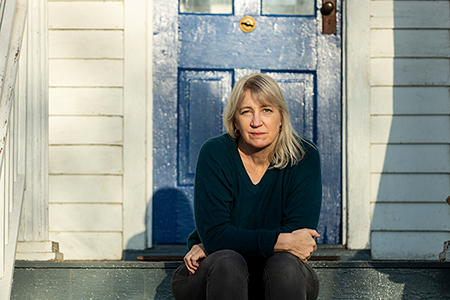
Photo courtesy of M Lund Assocites
Beyond basic co-op best practices that define roles and responsibilities, communications, and finance, Lund says the benefits of "value-added" agriculture aren't measured in profits alone. "Members bring their voices together not just in marketing, but in advocacy, education, and on regulatory issues," she explains. "SWGMC is building awareness and working to change perceptions to establish their market. It takes allies like the florists to help them make these big changes in the marketplace."
Co-ops also benefit from a federal law called the Capper–Volstead Act, which provides limited antitrust exemption to producer co-ops. Essentially, Capper–Volstead legally allows farmers "to enjoy legal protection as a formal co-op to collectively process and market their products, including setting prices together," she says.
The Alaska Peony Cooperative (APC) was formed after a group of peony growers sought an alternative to relying on a single distributor, which was another channel Lojewski considered for her peony stem sales. She volunteered to research other options and landed on forming a peony cooperative. The group began with a shoestring budget, as five farms each contributed a nonrefundable buy-in of $750. The membership has changed as people retired or closed their farms but the model has remained consistent, with farms contributing 20% of every stem sold to the co-op for marketing and operating costs.
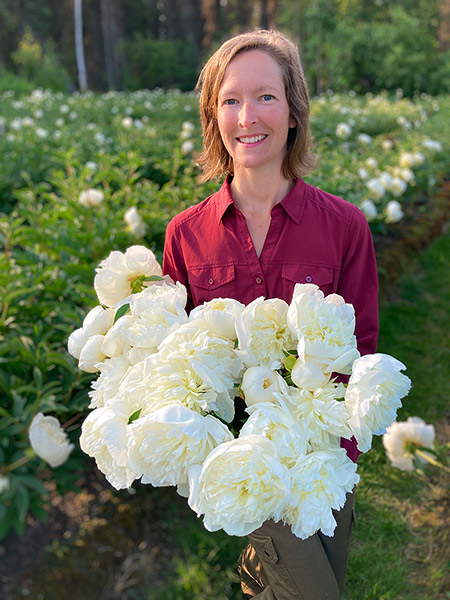
Photo courtesy of Alaska Peony Cooperative. Variety is 'Duchesse de Nemours'.
APC has about 10 members at any given time and does not maintain a physical location, Lojewski explains. "We've talked with other cooperatives of growers who bring their harvest to a central warehouse, but because our (customer) market is not in Alaska, we couldn't do that. The whole business kind of exists up in the air, up in space. I always say it exists on my phone and my laptop because those are the two assets that the co-op owns."
Lojewski further explains how forming a co-op forced the original farmers to make critical decisions about their business objectives. "We keep going back to questions such as:
- Why did we form?
- What is our goal?
- What is our mission and vision?
"This enables us to support those objectives rather than getting sidetracked. Our goals are threefold:
- Education
- Sales
- Supporting our members
"If something doesn't support one of those three goals, we pass on it." Standard operating procedures guide the farms to keep things consistent when it comes to harvesting, grading, and boxing peonies for shipping to customers in the Lower 48 states.
APC's 2021 season ended with incredible growth, Lojewski says. "We've doubled our sales every single year and went from selling 25,000 stems in 2020 to 50,000 stems this year — in just a few weeks. I wanted to see how many peonies we could sell to the max, so we sold out every stem that I could find to sell, whether from my farm, our member farms, or even non-member farms. Now we know what is possible but also what we need to grow. The only way we can sustain growth in the future is with better software and a sales assistant." She found a sales assistant and says this winter will be focused on improving APC's software to scale for next year's anticipated growth.
Szukovathy estimates that Jello Mold Farm has realized 60% growth in revenue, even after the extra costs of paying the co-op fee. "Someone else may have a model that I haven't figured out, but I couldn't even get close to having the time on my little farm to do all of the work of farming plus the work of selling my flowers."
Adds Lund: "There is an amount of risk. You have to have people who are willing to jump in and say they believe that the pie is going to get bigger for everyone. They realize they may earn less per stem, but they're going to save time and become more stable. And, do what they love, which is grow flowers."
2 • Multi-Member LLC
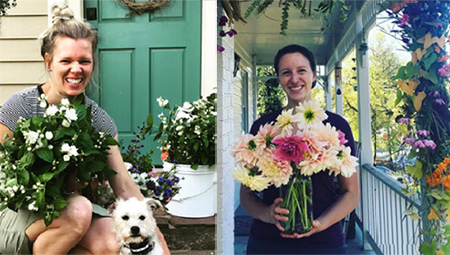
Photos courtesy of Melissa Webster & Megan Wakefield
Even though the word "cooperative" is in its name, the newly-formed Old Dominion Flower Cooperative (ODFC) is, in fact, a for-profit limited liability company (LLC) with 11 owners, both flower farmers and florists, based in the greater Washington, DC marketplace.
For now, the model of a business hub for local flowers is working just fine, says director of operations Megan Wakefield. "We started up as quickly as we could, so we went with a multi-member LLC. In the future we'll have to decide whether we like this model or want to become a formalized co-op. Some of our growers who aren't owners enjoy not having to attend meetings and participate in the administration of the business!"
ODFC got its start in late 2020 when Melissa Webster, a relatively new flower grower and owner of Old Soul Flower Co., brainstormed with Haley Tobias of Cedar and Lime Collective, one of her florist-customers, about how a collective hub for flowers would benefit the local marketplace.
"We have a lot of great growers and supporters here, so I just started calling people," Webster recalls. "I wanted to bring everyone to the table, because I realized that if we're ever going to grow this movement, we need florists to be educated about local flowers; we need them to also understand pricing and the farmers' perspective. And the farmers need to have a relationship with the designers and the floral studios to understand what they need."
By early 2021, 11 founders (eight flower farms and three florists) incorporated as an LLC and each contributed $500. They used the seed funds to purchase their first flower cooler and build the ODFC website.
Additional funds come from the $100 annual fee paid by both florists and growers to either sell or buy through the market, and there is an additional $75 fee for florists who want early access to the weekly availability list for pre-ordering.
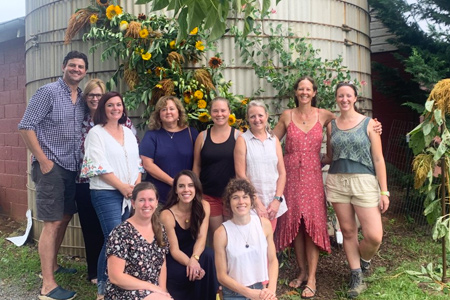
Pictured above:
Back row, L to R: Tom Precht & Sarah Daken (Grateful Gardeners, owners & growers for ODFC), Dusty Morlier (Wild Blue Farm, owner & grower for ODFC), Malinda Garris (Three Joi Flower Farm, grower for ODFC), Neta Fay Shanholtz (Shanholtz Farm, owner & grower for ODFC), Cory Lisk (Small Ventures Flower Farm, grower for ODFC), Sharla Bond (C&S Farmstead, owner & grower for ODFC), Megan Wakefield (Walking Wild Gardens, owner & grower for ODFC)
Front row, L to R: Haley Tobias (Cedar and Lime Collective, owner of ODFC & designer/buyer), Amy Cordy (Drive by Flowers, owner of ODFC & designer/buyer), Sage Devlin (Far Bungalow Farm, grower for ODFC)
Photo courtesy of ODFC
"We are a little different from other models," Webster explains, "in that the farmer sets the wholesale price and they get 100% of that price. Then, we add a 'stem tax' on top of that price, which goes back into ODFC and pays Megan as our director."
ODFC's market is built on a Shopify platform. Growers indicate what they expect to have available each week and Wakefield posts that availability. "So the buyers are essentially pre-ordering and then once the harvest is made, the sale is solidified," Wakefield says.
The demand for flowers almost immediately stretched the capacity of ODFC's 8x10-foot cooler, originally installed in a warehouse owned by a fitness center. "We quickly ran out of space in that cooler, so we had to relocate," Wakefield says. "Now we have two locations with two coolers, which has created a whole logistics challenge. And we're in the process of buying a shuttle bus to transport flowers. Every single thing about the business has changed in this first year, and our success in 2021 has been predicated on flexibility, a willingness to change and communicate with all of our stakeholders — because we have a lot of constituents."
After outgrowing their original location, the group built a large "staging cooler" at one of their grower's barns, convenient for most of the farmers to drop off their weekly harvest. "This region we're serving is huge — an approximately three-hour driving radius," Wakefield explains. "So now, I place orders with all the growers and they bring their flowers there on Tuesday morning. We process orders there and our drivers pick up for deliveries on Wednesdays. The smaller cooler was relocated to Cedar and Lime's studio in Northern Virginia, where florists can pick up smaller orders."
Wakefield is motivated to support all of the small businesses involved in ODFC — growers and designers — most of which are woman-owned. "We're all committed to our various goals. Some may have a primary goal of sustainability or supporting local flowers. My goal is that each of these businesses is sustainable, so that every single grower is earning a living wage and every designer feels like they have steady income."
3 • Sole Proprietor
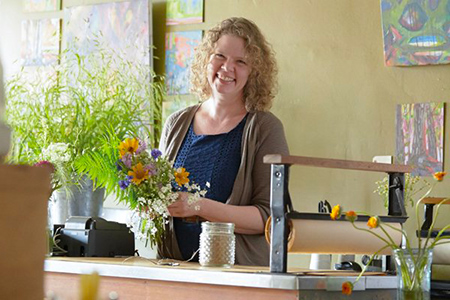
Photo courtesy of Christine Hoffman
Five years ago, Twin Cities Flower Exchange (TCFE) opened its doors in a suburb of St. Paul, leasing space and a large cooler at a regional organic food hub called The Good Acre. Founder Christine Hoffman had previously owned a retail flower shop called Foxglove Market, where she invested years in building relationships with Minnesota and Wisconsin flower farms that supplied her.
TCFE is a sustainable flower market for wholesale buyers, with an emphasis on local and chemical-free botanicals. "As more people found out that local flowers were an option and because I knew that more designers and florists wanted that option, it seemed like a no-brainer to create a marketplace for those flowers," she explains. "Of course, my vision as a retail merchandiser was to have a beautiful warehouse with a lovely flower market, which it is in some respects, but there's so much more that has to happen behind the scenes to get flowers into customers' hands."
Hoffman considered forming a cooperative before she established TCFE as a for-profit business that she owns entirely. While conventional flower wholesalers are often perceived as "middlemen," one reason for TCFE's success as a wholesale hub is that Hoffman is devoted to her relationships with the farms whose flowers she sells.
"Luckily, I had some farm relationships when I started, and I think people knew I was dedicated to making this work. So they stuck in there with me, none of us really knowing exactly what we were doing," she says. "Basically, I've created a logistics and communications company, which is such a far cry from being by myself in a studio creating floral arrangements."
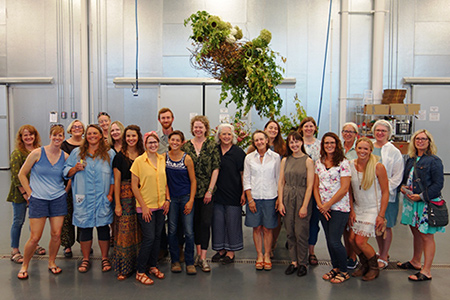
Photo courtesy of Slow Flowers, LLC
TCFE currently stocks cut flowers from 20-plus small flower farms in Minnesota and Wisconsin, and is open to wholesale customers two days a week. Buyers pay a $75 annual fee to shop at the market.
Hoffman doesn't require an exclusive from the farms, allowing them to market their flowers in a variety of ways that fit their location, crop mix, and seasonal production. "At this point, in year five, we have a proven sales record, so the farmers know the volume they can move through TCFE," she says. And she hopes that knowing the volume justifies the lower stem price required to market through a wholesale hub (versus selling retail at a farmers' market, for example). TCFE's pricing model is proprietary, but Hoffman says it varies depending on the crop.
She developed a "farm guide" with best practices for harvesting and preparing flowers for the market, including specs for stem length, bunch size, and how to organize flower buckets. Farmers drop off weekly orders at The Good Acre each Tuesday, and Hoffman and her team pull and organize pre-orders before the market opens to florists on Wednesday or Friday mornings.
Plans for an online store were accelerated during the pandemic. "It was the only thing we did for the first two months of our season last year," Hoffman notes. For the market days, farms can opt to fulfill pre-orders only or they can bring extra inventory for sale to walk-in customers.
"At this point, the farms and the buyers both know that I have their best interests (in mind) and I'm just trying to create a model that makes it easier for the people who choose to be part of this model."
Farmers Helping Farmers
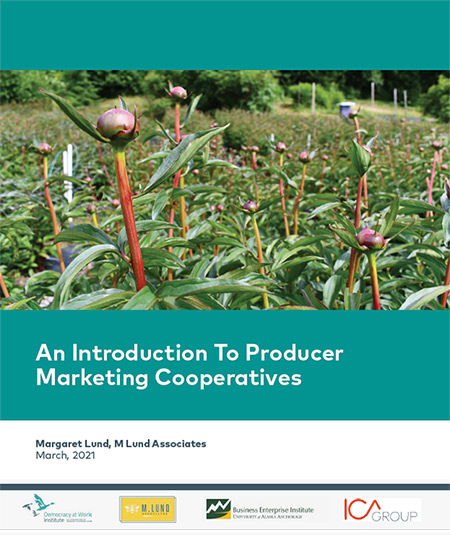
Lund is an expert in shared ownership strategies, with decades of experience advising small cooperatives in diverse sectors, including producer groups and marketing cooperatives.
An Introduction to Producer Marketing Cooperatives, published in March 2021 by M. Lund Associates, in collaboration with the Democracy at Work Institute / the U.S. Federation of Worker Cooperatives, the Business Enterprise Institute of the University of Alaska at Anchorage, and the ICA Group, an American not-for-profit entity specializing in consulting organizations wishing to become fully owned by the employees. © 2021 M. Lund Assoc. All Rights Reserved.
These are not the only collective selling options, and variations are made on the above three models as well. Similar to the Sole Proprietor model, for example, there is a "Competitor–Collaborator" system that brings together small and emerging farms with a lead farmer. This entails selling flowers through the lead farmer, usually a person(s) willing to coordinate customer communications and flower delivery on a regular basis, or perhaps to cover certain other needs, or costs for a set period of time.
I've featured a few of these unique arrangements in few past episodes of the Slow Flowers Podcast, and find that success is often based on trust between some farmers who just want to grow and other farmers who excel at marketing and selling as well as growing flowers. This option appeals to small and emerging farms, often in a well-defined region, who don't have the sales expertise of a more seasoned grower who acts as the broker or distributor on their behalf.
It takes so much cooperation and collaboration to make any of these models succeed, and a focus beyond profit motive alone: For the "greater good" of an industry or movement. The people featured in this article, like many others doing similar work around the country, are part of a major shift taking place in the floral marketplace. Says Lund: "Collaborative selling comes from everybody taking a step into the circle and accepting that there is risk together."


